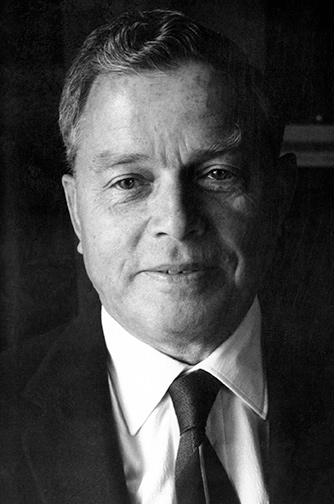History
For over a century, Syracuse University has been at the forefront of communications education.
The history of the Newhouse School stretches back more than 100 years to the Department of Journalism, which was was established in 1919 as part of the new College of Business Administration (now the Whitman School of Management) at Syracuse University. In 1934, the School of Journalism was founded under Dean Lyle Spencer, with a curriculum dedicated mainly to print media.
That year—the year the FCC wrote the Communications Act that would shape the emerging field of broadcasting for decades to come—Syracuse became the first university in the nation to offer a college credit radio course. In 1947, the University launched WAER, one of the nation’s first college radio stations, which is now a part of the Newhouse School. And when television emerged in the years following World War II, SU was the first to offer instruction in this fledgling field.
In 1964, supported by a gift from Samuel I. Newhouse, the Newhouse Communications Complex was officially inaugurated in Newhouse 1, the award-winning I.M. Pei building, which housed the School of Journalism. (A year later, the building would be cited as one of the top four honor award winners of the American Institute of Architects.)
In his dedication speech, Mr. Newhouse noted, “It is right and fitting that such a communications center be located within a dynamic university with world-embracing interests. The many fields of study provide an unparalleled opportunity for the interplay of creative talents of the first rank.” President Lyndon B. Johnson joined Mr. Newhouse at the dedication that day in 1964, accepting an honorary degree and delivering the “Gulf of Tonkin Speech” on the Newhouse Plaza.
Read about the Newhouse 1 dedication>>
Further growth came in 1971 when the School of Journalism merged with the Television and Radio Department, which had been located in the School of Speech and Dramatic Art. This merger marked the birth of the S.I. Newhouse School of Public Communications, named in honor of its main benefactor, and prompted the construction of a second building, Newhouse 2, which was dedicated in 1974 with a keynote address by William S. Paley, chairman of the board of CBS. The school became the most comprehensive, stand-alone school of its type in the nation—and remains so today.
In 2003, the Newhouse School received a $15 million gift from the S.I. Newhouse Foundation and the Newhouse family to fund the construction of the third building in the Newhouse Communications Complex. Newhouse 3 was dedicated on September 19, 2007, with a keynote address from Chief Justice of the United States John G. Roberts. The event was attended by the sons of S.I. Newhouse, S.I. Newhouse Jr. and Donald Newhouse, and their families.
Beginning in 2012, supported by lead gifts from the Kari and Dick Clark Foundation (Dick Clark ’51 was a Syracuse alumnus) and Cablevision Industries founder Alan Gerry, Newhouse 2 underwent an $18 million renovation to enhance and expand its studio facilities. Dubbed the Newhouse Studio and Innovation Center, the new space was dedicated in 2014 with special guest Oprah Winfrey.
In 2020, the Samuel I. Newhouse Foundation pledged $75 million to the Newhouse School, the largest gift in Syracuse University’s 150-year history.
Deans of the Newhouse School
- Lyle Spencer (School of Journalism), 1934-1950
- Wesley Clark (School of Journalism), 1950-1952 (acting dean), 1952-1972
- Henry Schulte, 1972 (acting dean), 1973-1980
- Edward Stephens, 1980-1981 (acting dean), 1981-1989
- Lawrence Myers Jr., 1989-1990 (interim dean)
- David Rubin, 1990-2008
- Lorraine Branham, 2008–2019
- Amy Falkner, 2019 – 2020 (interim dean)
- Mark J. Lodato, 2020-present

Samuel I. Newhouse
At the age of 13, Samuel I. Newhouse was an office boy for a lawyer in Bayonne, N.J. At 15, he was the lawyer’s office manager and accountant. At 16, he was publisher of a small daily newspaper the lawyer had acquired in payment of a debt. At 21, he was half owner of the paper and had himself become a lawyer. By the age of 30, he was sole owner of the Staten Island Advance and on his way to becoming a world media giant.
Newhouse died in 1979 at the age of 84. The company he founded, Advance Publications, continues to thrive, and today owns newspapers in 26 American cities as well as Condé Nast Publications, Parade Publications, Fairchild Publications, American City Business Journals, the Golf Digest Companies, Newhouse News Service, Religion News Service and Bright House Networks, which serves 2.4 million cable system customers in Florida, California, Michigan, Indiana and Alabama. The company also owns Advance Internet, which operates more than 100 websites serving its print publications and cable systems.
Advance newspapers include the Star Ledger of Newark, N.J.; the Plain Dealer of Cleveland, Ohio; the Oregonian, of Portland, Oregon; and the Post-Standard of Syracuse, N.Y. Magazines, published in six countries, include Vogue, Glamour, W, The New Yorker, Vanity Fair, GQ, Gourmet, House and Garden and Parade, the Sunday newspaper supplement, which is the largest circulation magazine in the United States.
Newhouse was justly proud of his accomplishments, but proudest that he created a new kind of national publishing group in the United States, the first to allow editors and publishers to make their own editorial and news coverage decisions. He called it local autonomy and it was copied, over the years, by the other national publishing groups. In an editorial following his death, The New York Times said, “S.I. Newhouse demonstrated that editorial autonomy in newspaper chains could be both good business and good journalism. In an era of growing consolidation in newspaper ownership, that lesson is a legacy.”
Newhouse left control of Advance Publications to his two sons, S.I. Newhouse Jr. and Donald Newhouse, who continued the policy of local autonomy as they expanded both the newspaper and magazine branches of the private family business. The third and fourth generations of the Newhouse family are now actively involved in the management of the business as well.